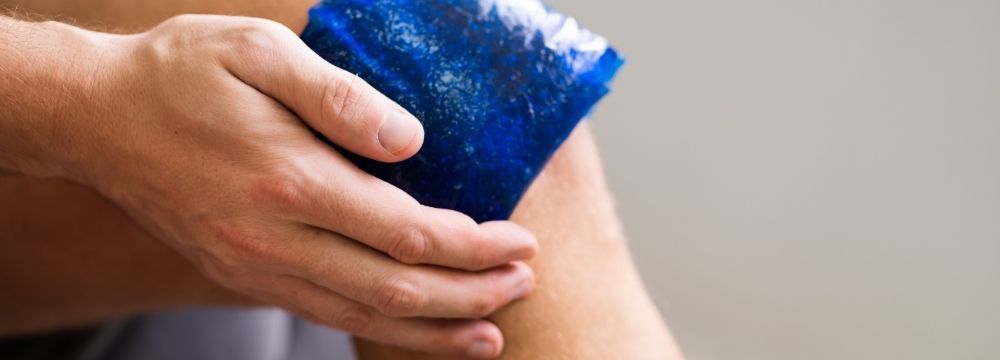Home Care For Sports-Related Knee Injuries

When we think of sports injuries, our minds typically go to children’s sports, especially those particularly hard on the knee, like soccer. However, you might be surprised to know how many adults visit our offices and ERs due to significant knee injuries. Of course, as we age, the combination of weakened musculature and the tendency to over-exert, whether to impress or make ourselves feel better, can create a genuinely problematic knee injury situation. The cutting, twisting, turning, and kicking motions can strain the knee. This is true in children and adults alike – especially those who aren’t adequately conditioned or have not warmed up appropriately. Many minor injuries can be treated at home, with an eye toward specific markers that would suggest urgent or even emergent intervention is necessary.
Initial Home Treatment and Medication Options
Swelling of the knee can initially be treated with RICE – Rest, Ice, Compression (heat wraps with or without a light ace wrap or sleeve), and Elevation. Ice should be administered for only 15 minutes a few times a day and not directly on the skin. Compression should not hurt the knee and must not be too tight.
From a medical standpoint, there are many effective over-the-counter painkillers and anti-inflammatories, including ibuprofen and naproxen, which should be taken as directed. Remember that some other painkillers, such as acetaminophen, do not offer anti-inflammatory benefits. Many patients may also find relief with gels and creams applied to the injured area (avoid broken skin!). These usually provide temporary relief that should not be considered as treatment.
Specific medication regimens should be directed by your orthopedic surgeon or primary care physician. Still, in general, after several days of requiring medication or extra rest measures to alleviate pain, without much improvement, patients should expedite a visit to their doctor for evaluation and possible imaging.
How Much Rest Is Too Much?
Treatment of acute injuries also includes dedicated rest from the stress of competition and exercise. In strains and sprains, rehabilitation or strengthening of supportive muscles around knee ligaments may expedite renewed stability. However, too much rest can lead to muscle atrophy resulting in the weakening of ligaments.
Diagnostic Exams
Specialized exams that test for ligament stability may detect severe or even less obvious instability at the time of injury or especially a week after as swelling subsides. Often, there is severe pain in a knee ligament rupture followed by almost no pain (often because of adrenaline), leaving only instability as a sign of injury before swelling has set in. Further injury is a risk of not addressing this.
Bottom Line: A proper evaluation must be sought for high-stress injuries, rapid swelling, or instability before returning to competition or even weight-bearing activity.
For longer-term injury, despite sticking to treatments as prescribed, or especially in instances of significant instability on exam and activity that may require more intervention to treat effectively, MRI (Magnetic Resonance Imaging) may be ordered. These diagnostics are more and more accurate in identifying and differentiating areas of inflammation and partial or complete tear of ligaments, tendons, meniscus, and cartilage. While x-rays may also be taken, they do not have the sensitivity or precision of an MRI. Further, they cannot visualize soft tissue and are only truly effective in diagnosing more obvious fractures.
When to See Your Orthopedic Surgeon, Orthopedic Urgent Care, or ER
With graded tears (partial or complete), multiple ligament involvement, insertion/origin disruption or inflammation, rest and rehab may not prove effective or quick enough to satisfy the demands of competition. Further, some apparent or underlying injuries may need immediate care. Below are just some of the many reasons to see a medical professional. If you believe you have a medical emergency, do not delay going to the ER or dialing 911.
- Numbness or tingling, especially around or below the knee injury – visit your orthopedic urgent care or ER.
- Head trauma, which can happen with any sports injury, should be evaluated by a medical professional. Serious head injuries should be seen at the ER.
- Swelling and pain at rest that cannot be controlled with home measures would likely benefit from urgent evaluation.
- Weight-bearing pain and instability require more urgent evaluation at facilities with the wherewithal to diagnose acute fractures and swelling of tell-tale areas consistent with severe ligament and tendon injuries.
There has been a rise in orthopedic and sports medicine practices with Orthopedic Urgent Care clinics and experienced practitioners with rapid imaging available for assessments. Premier Ortho is committed to seeing patients with fractures or suspected knee injuries within the same week. For persistent or severe knee pain or trauma, contact our office to schedule an evaluation as soon as possible.


 ES
ES